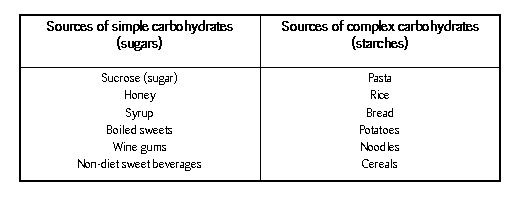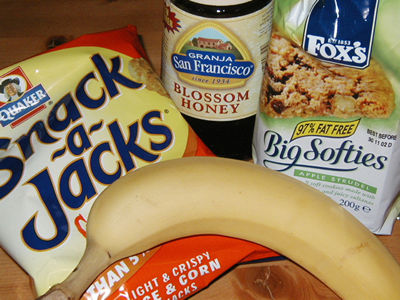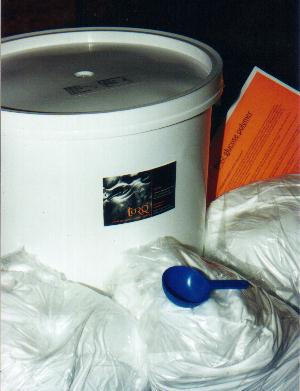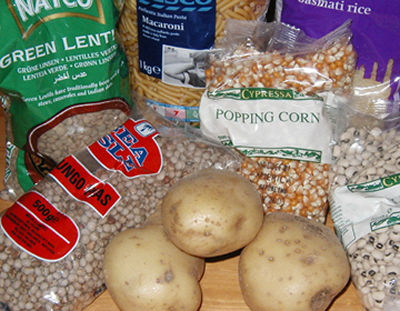Carbohydrate is the key to metabolic energy. As well as providing your body with the means to release the energy stored in fat and oxygen (the so called “endurance fuels”), carbohydrate is also called upon when the going gets tough. If the pace in a race suddenly accelerates, or the intensity of exercise is so high that fat and oxygen alone can no longer sustain the energy demand, carbohydrate is used anaerobically (without oxygen) to satisfy this requirement. If your legs start burning, this is caused by a build up of lactic acid, the exhaust fumes of carbohydrate metabolism. So next time your legs burn, you’ll know you’re using carbo power. In short. without carbohydrate, our metabolism would grind dramatically to a crawl.
Carbohydrate and ‘Overload’
For detailed information on the concept of ‘Overload’, refer to the following related features:
Training Theory 1
Training Theory 2
Without the correct use of carbohydrate, your training gains will be limited. All too often, riders make huge sacrifices with their time when it comes to training, with relatively little regard to their nutrition. A high carbohydrate diet will provide you with the energy to train in the first place. If you feel lethargic, your legs are heavy and they hurt, or lack power when you ride, you’ve probably not consumed enough carbohydrate. When fully loaded with carbs, you’ll ride faster, harder and for longer. This means that you will get a greater overload and hence, a better training effect if you stick to a high carb diet. A diet rich in carbohydrate will also quicken your recovery time between sessions, so not only will your sessions be more effective, but also you’ll be ready for the next one sooner.
If you refer to the diagrams displayed in the feature Training Theory 2, with a high carb diet, the overload will be greater, the recovery quicker and the peaks larger. All of this will lead to significantly enhanced performance over a period of time.
The different types of carbohydrate
Carbohydrates vary from the simple mono and disaccharide’s like glucose and sucrose respectively, through to the long chain oligosaccharides present in pasta, potatoes and similar starch rich foods. Unlike simple sugars, which are quickly used up, giving the so-called “sugar rush” (a short-term effect of limited value), a complex carbohydrate can be utilised by the body over a long period of time and therefore provides a sustained release of energy. Complex carbohydrate foodstuffs also contain protein, dietary fibre and traces of vitamins and minerals, compared to simple sugars, which tend not to.

For these reasons, you should try to obtain the majority of your carbohydrate from complex forms. Sometimes though, when training load is particularly high, it is impossible to consume enough carbohydrate calories through eating complex sources alone, due to their bulky nature, so this is where the simple forms are useful. For instance, imagine eating four thick slices of toast. If you were to add a generous spreading of honey to this toast, you would double the carbohydrate calories. Simple sugars contain no bulky fibre to pad them out, making them a very potent source of energy. If you are training very hard and occasionally crave for something sweet, why not give in; your muscles probably need it! Be careful with your choices though, because treats like cakes, biscuits and chocolate also contain a lot of fat.
Fructose is the name of the simple sugar contained within fruit and like complex carbohydrate, fruit contains a myriad of functional micro-nutrients and fibre. Again however, when demand for energy is high, fruit is generally too bulky to be an effective choice. Dried fruit however contains practically everything that fresh fruit does, without the bulk. If you eat one hundred grams of raisins for instance, you’ll get a lot more carbohydrate than in the same measure of grapes. They’re also a lot easier to carry around with you. Try raisins, figs, dried apricots and dried apple. Be careful with some dried banana products, because many are deep fat fried. Let it also be noted that fructose has a low ‘Glycaemic Index’, so although great for general refuling and snacking, it’s not the most effective fuel when you’re exercising (unless of course it’s mixed with some higher glycaemic index ingredients like in an energy bar).
If you fancy a treat, try to go for snacks that are high in carbohydrate, but low in fat. Here are some suggested high carb/low fat snacks:
· Bananas and grapes with natural yoghurt and lashings of honey.
· Foxes ‘Big Softies’ (I particularly like the apple strudel ones 1.6g of fat per 100g)
· Jacobs ‘Caramel Snackajacks’ (3.5g of fat per 100g)

Alternatively, go to the biscuit isle at your local supermarket and check the back of the packets for their fat content. Aim for about five grams of fat per hundred or less.
Glucose Polymer (Maltodextrin)
There are a number of glucose polymer/sports drinks available on the market, including brand names such as Maxim, High Five, SIS and of course TORQ. The wonderful thing about a glucose polymer is that it possesses all the properties of a complex carbohydrate with a number of benefits.
A glucose polymer’s molecular profile optimises the long-term energy providing properties of complex carbohydrates, without the need to consume bulky starch-rich foods. These bulky foods take a longer time to digest and can bloat your stomach because of the fibre that they contain. Fibre is an important nutrient in as much as it helps to keep waste moving through your body, but metabolically it’s useless. Glucose polymer looks and dissolves in water like a sugar, but the similarity ends there. It is not sweet and because it is actually a complex carbohydrate, it behaves like one once it’s in your bloodstream. Also, because it is very low in bulk, it’s an incredibly effective way of getting carbohydrate calories in. You can even add it to tea, coffee or your meals. When I was training heavily (once upon a time), I often made a ‘bionic soup’ by adding 4-5 scoops of the stuff while it was simmering.

Although dry pasta has roughly the same amount of energy as pure glucose polymer, when cooked, one hundred grams of pasta has about one third of the calories, because of the water it absorbs. Manufacturers of sports drinks generally recommend that one hundred grams of glucose polymer should be dissolved into about seven hundred and fifty millilitres of water for optimal consumption. This means that in one bottle of sports drink, you will get the same amount of calories as you would from a large bowl of pasta. If I asked you to eat 4 large bowls of pasta per day on top of your normal meals, I think you’d struggle, but you’d put four bottles away easily.
Don’t ignore the benefits of eating foods such as pasta, rice, potatoes and bread, but as a guide, use a glucose polymer to supplement your calorie intake in the following circumstances:
· While you are riding the bike. It is very unlikely that you will replace all of the energy you are using, unless you are riding particularly slowly, but research has proven that complex carbohydrates taken in this way will delay the onset of fatigue.
· Within 30 minutes of finishing riding your bike. This is the best time to get carbo’s into your system (while enzyme activity is elevated), and a bowl of pasta isn’t always appealing at this time. Having a protein source at this time is also advisable as this has been shown to further enhance glycogen synthetase (enzyme) activity.
· As a supplement to your regular food during heavy training/racing periods (sometimes it is just impossible to get enough calories from a regular diet to fuel your performance).
· As a “carbo-loader” to help you peak for that important race. Carbo-loading is too complex to discuss at this point, so will be covered at some point as a separate feature.
Click here if you’re interested in finding out more about TORQ’s glucose polymer (TORQ energy).







